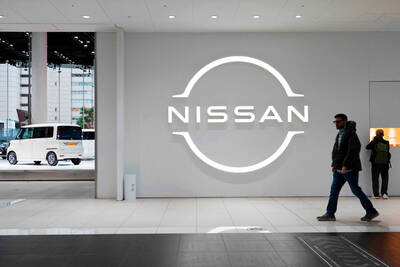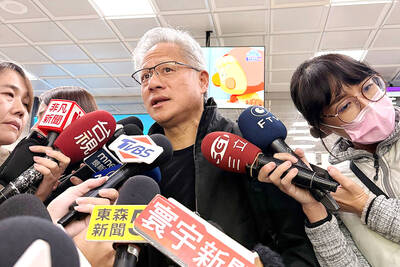Japanese scientists have succeeded in transmitting energy wirelessly, in a key step that could one day make solar power generation in space a possibility, an official said yesterday.
Researchers used microwaves to deliver 1.8 kilowatts of power — enough to run an electric kettle — through the air with pinpoint accuracy to a receiver 55m away.
While the distance was not huge, the technology could pave the way for mankind to eventually tap the vast amount of solar energy available in space and use it on Earth, a spokesman for the Japan Aerospace Exploration Agency (JAXA) said.
“This was the first time anyone has managed to send a high output of nearly 2 kilowatts of electric power via microwaves to a small target, using a delicate directivity control device,” he said.
JAXA has been working on devising a space solar power systems (SSPS) for years, the spokesman said.
Solar power generation in space has many advantages over its Earth-based cousin, notably the permanent availability of energy, regardless of weather or time of day.
While man-made satellites, such as the International Space Station, have long since been able to use the solar energy that washes over them from the sun, getting that power down to Earth where people can use it has been the thing of science fiction.
However, the Japanese research offers the possibility that humans could one day be able to farm an inexhaustible source of energy in space.
The idea would be for microwave-transmitting solar satellites — which would have sunlight-gathering panels and antennae — to be set up about 36,000km from Earth, the JAXA spokesman said.
“But it could take decades before we see practical application of the technology — maybe in the 2040s or later,” he said. “There are a number of challenges to overcome, such as how to send huge structures into space, how to construct them and how to maintain them.”
The idea of space-based solar power generation emerged among US researchers in the 1960s and Japan’s SSPS program, chiefly financed by the Ministry of Economy, Trade and Industry, started in 2009, he said.
Resource-poor Japan has to import huge amounts of fossil fuel. It has become substantially more dependent on these imports as its nuclear power industry shut down in the aftermath of the Fukushima Dai-ichi nuclear disaster in 2011.

Nissan Motor Co has agreed to sell its global headquarters in Yokohama for ¥97 billion (US$630 million) to a group sponsored by Taiwanese autoparts maker Minth Group (敏實集團), as the struggling automaker seeks to shore up its financial position. The acquisition is led by a special purchase company managed by KJR Management Ltd, a Japanese real-estate unit of private equity giant KKR & Co, people familiar with the matter said. KJR said it would act as asset manager together with Mizuho Real Estate Management Co. Nissan is undergoing a broad cost-cutting campaign by eliminating jobs and shuttering plants as it grapples

PERSISTENT RUMORS: Nvidia’s CEO said the firm is not in talks to sell AI chips to China, but he would welcome a change in US policy barring the activity Nvidia Corp CEO Jensen Huang (黃仁勳) said his company is not in discussions to sell its Blackwell artificial intelligence (AI) chips to Chinese firms, waving off speculation it is trying to engineer a return to the world’s largest semiconductor market. Huang, who arrived in Taiwan yesterday ahead of meetings with longtime partner Taiwan Semiconductor Manufacturing Co (TSMC, 台積電), took the opportunity to clarify recent comments about the US-China AI race. The Nvidia head caused a stir in an interview this week with the Financial Times, in which he was quoted as saying “China will win” the AI race. Huang yesterday said

TEMPORARY TRUCE: China has made concessions to ease rare earth trade controls, among others, while Washington holds fire on a 100% tariff on all Chinese goods China is effectively suspending implementation of additional export controls on rare earth metals and terminating investigations targeting US companies in the semiconductor supply chain, the White House announced. The White House on Saturday issued a fact sheet outlining some details of the trade pact agreed to earlier in the week by US President Donald Trump and Chinese President Xi Jinping (習近平) that aimed to ease tensions between the world’s two largest economies. Under the deal, China is to issue general licenses valid for exports of rare earths, gallium, germanium, antimony and graphite “for the benefit of US end users and their suppliers

Dutch chipmaker Nexperia BV’s China unit yesterday said that it had established sufficient inventories of finished goods and works-in-progress, and that its supply chain remained secure and stable after its parent halted wafer supplies. The Dutch company suspended supplies of wafers to its Chinese assembly plant a week ago, calling it “a direct consequence of the local management’s recent failure to comply with the agreed contractual payment terms,” Reuters reported on Friday last week. Its China unit called Nexperia’s suspension “unilateral” and “extremely irresponsible,” adding that the Dutch parent’s claim about contractual payment was “misleading and highly deceptive,” according to a statement